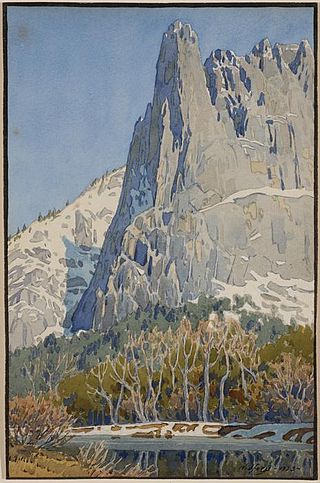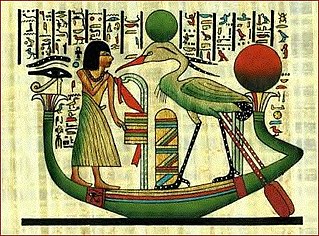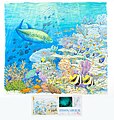
Watercolor or watercolour, also aquarelle, is a painting method in which the paints are made of pigments suspended in a water-based solution. Watercolor refers to both the medium and the resulting artwork. Aquarelles painted with water-soluble colored ink instead of modern water colors are called aquarellum atramento by experts. However, this term has now tended to pass out of use.

Frederic Edwin Church was an American landscape painter born in Hartford, Connecticut. He was a central figure in the Hudson River School of American landscape painters, best known for painting large landscapes, often depicting mountains, waterfalls, and sunsets. Church's paintings put an emphasis on realistic detail, dramatic light, and panoramic views. He debuted some of his major works in single-painting exhibitions to a paying and often enthralled audience in New York City. In his prime, he was one of the most famous painters in the United States.

Winslow Homer was an American landscape painter and illustrator, best known for his marine subjects. He is considered one of the foremost painters of 19th-century America and a preeminent figure in American art in general.

Thomas Moran was an American painter and printmaker of the Hudson River School in New York whose work often featured the Rocky Mountains. Moran and his family, wife Mary Nimmo Moran and daughter Ruth, took residence in New York where he obtained work as an artist. He was a younger brother of the noted marine artist Edward Moran, with whom he shared a studio. A talented illustrator and exquisite colorist, Thomas Moran was hired as an illustrator at Scribner's Monthly. During the late 1860s, he was appointed the chief illustrator for the magazine, a position that helped him launch his career as one of the premier painters of the American landscape, in particular, the American West.

Richard Parkes Bonington was an English Romantic landscape painter, who moved to France at the age of 14 and can also be considered as a French artist, and an intermediary bringing aspects of English style to France. Becoming, after his early death, one of the most influential British artists of his time, the facility of his style was inspired by the old masters, yet was entirely modern in its application. His landscapes were mostly of coastal scenes, with a low horizon and large sky, showing a brilliant handling of light and atmosphere. He also painted small historical cabinet paintings in a freely-handled version of the troubadour style.
George Raper was a Royal Navy officer who as an able seaman joined the crew of HMS Sirius and the First Fleet to establish a colony at Botany Bay, New South Wales, now Australia. He is best known today for his watercolour sketches of the voyage and settlement, particularly birds and flowers of Sydney Cove.

Frances Anne Hopkins was a British painter. She was the third of Frederick William Beechey's five children. In 1858, she married a Hudson's Bay Company official, Edward Hopkins, whose work took him to North America. Hopkins travelled along with him. While sailing, she was able to sketch extensively, therefore, capturing a now lost way of living – the last days of the fur trade.

Stanisław Masłowski was a Polish painter of realistic style, the author of watercolor landscapes.

Delmer J. Yoakum was an American fine artist, oil and watercolor painter, designer, serigrapher, Disneyland and Hollywood motion picture studio scenic artist.
Tayo Adenaike is a Nigerian painter.

Herbert Alexander Collins, Sr., (1865–1937) was a Canadian-born American artist. He was known nationally in the United States as a landscape and portrait painter.

Gunnar Mauritz Widforss was a Swedish American artist who specialized in painting subjects from the wilderness in watercolor. Widforss is most frequently associated with landscapes from American National Parks.

Albert Goodwin (1845–1932) was an English landscapist specialising in watercolours. His work shows the influences of Turner and the Pre-Raphaelite Brotherhood. Goodwin was born in Maidstone in Kent, the son of a builder and one of 9 children. After leaving school he became an apprentice draper. His exceptional artistic ability was recognised at an early age and he went on to study with the Pre-Raphaelite artists Arthur Hughes and Ford Madox Brown - the latter predicting that he would become "one of the greatest landscape painters of the age".

John William North was a British landscape painter and illustrator, a prominent member of the Idyllists.
Alden Lee Mason, né Carlson was an American painter from Washington known for creating abstract and figurative artwork. Mason was a professor of art at the University of Washington for over 30 years. His painting are held in a number of public collections including the San Francisco Museum of Modern Art, the Seattle Art Museum, the Portland Art Museum, and the Milwaukee Art Museum.

James West Fraser is an American artist. One of the leading artists in the representational/En Plein Air tradition, Fraser has built his career on richly painted, atmospheric vistas of cities, coasts, and landscapes.

Watercolor paper is paper or substrate onto which an artist applies watercolor paints, pigments, or dyes. Many types of watercolour papers that are manufactured for the use of watercolors are currently available. Watercolor paper can be made of wood pulp exclusively, or mixed with cotton fibers. Pure cotton watercolor paper is also used by artists, though it typically costs more than pulp-based paper. It is also available as an acid-free medium to help its preservation.
Mary Marguerite Porter Zwicker was a Canadian artist and art promoter from Halifax, Nova Scotia. Known for her watercolor paintings of landscapes and villages in Nova Scotia, Zwicker exhibited her work at the Royal Canadian Academy of Arts, the Montreal Art Association, and the Art Gallery of Nova Scotia. Together with her husband, Leroy Zwicker, she owned and operated Zwicker's Gallery; for most of the 20th century, Zwicker's Gallery was the only Halifax gallery that routinely held art exhibits open to the public. It still operates.
Mary Josephine Walters (1837–1883), also known as Josephine Walters or M.J. Walters, was part of the 19th century American landscape painting movement known as the Hudson River School. She studied under Asher Durand and specialized in oil and watercolor painting. Though there is not much information about her life, her paintings exhibited much of the immense detail and precision that her mentor’s work did. Much of Walter's painting was done in the Adirondack and Catskill Mountains, though most of her currently known works are of the Hudson River.

The Foster Museum is a private non-profit single-artist museum located in Palo Alto, California, United States dedicated to the watercolor wilderness Journeys of artist-explorer Tony Foster (1946–). It houses the permanent collection of the Foster Art & Wilderness Foundation and opened to the public in 2016, offering free admission by appointment.




















